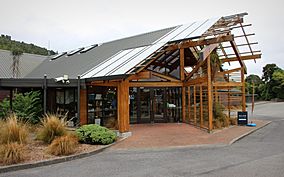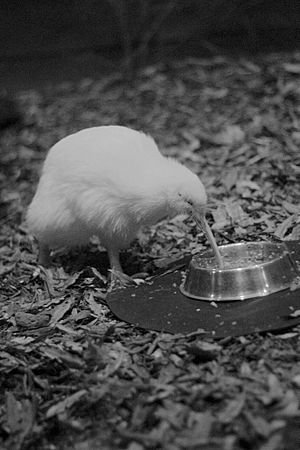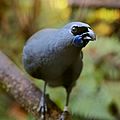Pukaha / Mount Bruce National Wildlife Centre facts for kids
Quick facts for kids Pukaha / Mount Bruce National Wildlife Centre |
|
|---|---|
 |
|
| Nearest city | Masterton, New Zealand |
| Area | 57.3 ha (142 acres) |
| Governing body | Pukaha Mount Bruce Board |
| Website | https://pukaha.org.nz/ |
Pūkaha / Mount Bruce National Wildlife Centre is a special place in New Zealand. It is a wildlife center where they help protect and breed native animals. It is also a fun visitor center located in a beautiful forest.
Contents
Where is Pūkaha?
Pūkaha / Mount Bruce National Wildlife Centre is on State Highway 2. It is about 30 kilometers (18 miles) north of Masterton. It is also 10 kilometers (6 miles) south of Eketahuna.
The center is inside a protected area of about 57 hectares (141 acres). This area is part of a much larger forest reserve. The bigger reserve is called Pūkaha / Mount Bruce Scenic Reserve. It covers about 891 hectares (2,200 acres). These areas are kept safe for wildlife.
A Look at Pūkaha's History
The forest land was bought by the government in the 1870s. It was part of a huge forest called "Seventy Mile Bush." Most of this big forest was cleared for farms. But the 942-hectare Mount Bruce area was saved as a forest reserve.
About 55 hectares of this reserve became a special Native Bird Reserve. It was managed by the Wildlife Service.
Starting the Wildlife Centre
A local man named Elwyn Welch was very good at raising birds. He even helped endangered birds. In the 1950s, he had success with the takahē bird.
In 1962, the center officially opened. Its main goal was to breed rare native birds and release them. The takahē was the first bird brought to the center. This bird was once thought to be extinct.
In the same years, many brown teal, buff weka, and kākāriki were released.
Growing the Reserve
In 2001, the entire forest became part of the wildlife reserve. This made the protected area much bigger. It grew from 55 to 942 hectares. This meant more space to breed birds and protect different species.
Workers also created about 100 kilometers (62 miles) of walking tracks. They set up thousands of traps and bait stations. This helped to control pests and make the area safer for native animals.
Rangitāne and the Land
In 2016, an important agreement was made. It was between the New Zealand government and the Rangitāne iwi. The Rangitāne are the original Māori people of this land. This agreement helped settle old claims about the land.
As part of this, the Māori name Pūkaha was added to the center's name. It also became part of the scenic reserve's name. A very special part of the agreement was about the land itself. The land was given back to Rangitāne. Then, Rangitāne gifted it back to all the people of New Zealand.
A ceremony happened on February 8, 2020, to mark the handover to Rangitāne. Another ceremony on May 1, 2021, celebrated Rangitāne gifting the forest back.
How Pūkaha is Run
The Pūkaha / Mount Bruce National Wildlife Centre is run by a group called the Pūkaha Mount Bruce Board. This board is a registered charity. It works together with Rangitāne and the Department of Conservation. This partnership helps make sure the center runs well.
What Pūkaha Does
Protecting Wildlife
Pūkaha's main goal is to help bring back native wildlife. They mostly work with birds. But they also help reptiles like the tuatara.
A big part of their work is controlling pests. Pests like rats, stoats, and possums can harm native animals. Pūkaha uses special traps to reduce these pest numbers. This helps native wildlife to thrive.
Bird Releases
Bird releases started in 1996. Nine kākā (a type of parrot) were released first. Now, there are about 160 kākā in the forest. The goal is to have 600 kākā in a few years.
In 2003, North Island brown kiwi and North Island kōkako were also moved here. More than 15 kiwi now live in the forest. Two kiwi live in the nocturnal house. They also incubate kiwi eggs to help chicks survive.
Manukura, the White Kiwi
One famous bird at Pūkaha was a rare white kiwi named Manukura. She was the first white kiwi hatched in captivity. A New Zealand author, Joy Cowley, wrote a children's book about her. Manukura sadly passed away in December 2020 at 10 years old.
Teaching and Learning
Many schools visit the center. Some schools even sponsor a kiwi. This lets them follow the kiwi's journey after it is released. Students learn about New Zealand's environmental challenges.
Pūkaha also has holiday programs. Local children can become "junior rangers." In 2020, a new conservation course started at Pūkaha. It teaches people about protecting nature.
Welcoming Visitors
Another important job for Pūkaha is welcoming visitors. They want to teach people about the environment. They also show how important it is to protect wildlife. About 40,000 people visit each year.
Pūkaha has a café and aviaries where you can see native birds. There is a special nocturnal house to see shy kiwi. You can join guided tours and watch daily feedings of kākā and eels. Pūkaha also offers night tours to look for kiwi and see glow worms.
The Pūkaha Team
Pūkaha has about 30 staff members. They also have around 50 volunteers. The team works on many things. This includes replanting the forest and controlling pests. They also work in the visitor center, communications, and the café.
Pūkaha is open every day except Christmas Day.
Images for kids







